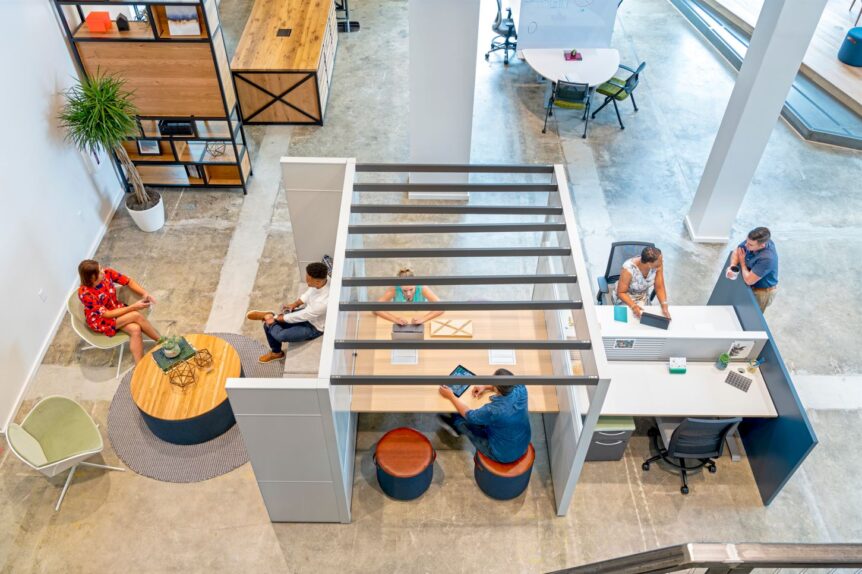The COVID-19 pandemic has revolutionized the way we work. More and more businesses are adopting hybrid work models, which means employees work both from the office and from home. This hybrid work model has its advantages and disadvantages, but one of the most significant challenges is designing a workspace that caters to the needs of both in-office and remote workers and is attractive to both. It is necessary to create a space which has advantages to working from home if we are to have employees who want to gladly return to the office even part time. In this article, we’ll discuss how to design an office space for a hybrid workforce.
1. Define the Needs of the Hybrid Workforce
Before you start designing an office space, it’s essential to understand the needs of your hybrid workforce. You should consider the size of your workforce, their job roles, their tasks, and their preferences. For example, some employees may need private workspaces, while others may require collaboration spaces. Some may need access to specialized equipment, while others may only need a laptop and an internet connection.
You should also consider the preferences of your remote workers. Some may prefer dedicated home office style privacy, while others may prefer to work from a coffee shop or a co-working space. Understanding the needs and preferences of your hybrid workforce will help you design an office space that caters to their needs and ensures they are as effective as possible when in either location.
2. Create a Flexible Workspace
One of the biggest advantages of a hybrid work model is flexibility. You should design an office space that is flexible and adaptable to the changing needs of your workforce. Your office space should allow for different work modes, such as focused work, collaboration, and socialization.
These spaces should also be easy to access. A growing trend even before the pandemic was the concept of the activity based working environment in which there would be a space for every type of work in close proximity to every team.
One way to create a flexible workspace is to use furniture that can be easily reconfigured. For example, you can use desks with wheels that can be moved around to create different workspaces. You can also use movable walls, screens, whiteboards or partitions to create private workspaces or collaboration areas.
3. Incorporate Technology
Technology is an essential component of a hybrid work model. Your office space should be designed to accommodate the technological needs of your hybrid workforce. You should provide high-speed internet access in all areas of the space, video conferencing equipment, and other essential tools to ensure your employees can work effectively from the office or from home and those that are home do not have a lessened experience during meetings.
You should also incorporate technology into your office space design. For example, you can use digital signage to display important information which changes in a flexible space or use smart lighting systems to adjust the lighting based on the time of day or the tasks being performed.
4. Provide Comfortable and Ergonomic Furniture
Your hybrid workforce will spend a significant amount of time sitting and working at their desks, whether they’re in the office or at home. Therefore, it’s essential to provide comfortable and ergonomic furniture that supports their health and wellbeing.
This means you should have a mix of traditional office task chairs and more comfortable lounge seating to provide support when needed for long term focus work and residential feel to bring some of the comfort and warmth of home into the office when appropriate.
Ergonomic furniture is designed to promote good posture, reduce the risk of injury, and improve comfort. You should invest in ergonomic chairs, desks, and accessories that cater to the needs of your hybrid workforce. For example, adjustable chairs and desks allow employees to customize the height and angle of their workstation to their liking.
5. Create a Healthy Work Environment
Creating a healthy work environment is essential for the wellbeing of your hybrid workforce. A healthy work environment should be well-ventilated, well-lit, and free from distractions.
A new standard of design gaining momentum is the WELL Building certification which focuses on designing spaces which are focused on the overall wellbeing of the people who will occupy the space rather than just work efficiency or environmental impact of a building.
You can improve air quality by providing plants or using air purifiers. You can also use natural light or adjustable lighting systems to create a comfortable and healthy work environment. You should also ensure there are spaces within the office free from distractions, such as noise or clutter, to allow focus, mental clarity and productivity.
In conclusion, designing an office space for a hybrid workforce requires careful consideration of their needs, preferences, and the demands of the job. A flexible workspace, incorporating technology, comfortable and ergonomic furniture, creating a healthy work environment, and using sustainable materials are essential components of an effective office space. By creating a workspace that caters to the needs of both in-office and remote workers, businesses can promote productivity, creativity, and wellbeing.

